Actuators, Vol. 12, Pages 129: Effect of Material Properties on Fiber-Shaped Pneumatic Actuators Performance
Actuators doi: 10.3390/act12030129
Authors: Muh Amdadul Hoque Emily Petersen Xiaomeng Fang
Thin fiber-shaped pneumatic artificial muscle (PAM) can generate contractile motions upon stimulation, and it is well known for its good compliance, high weight-to-power ratio, resemblance to animal muscle movements, and, most importantly, the capability to be integrated into fabrics and other textile forms for wearable devices. This fiber-shaped device, based on McKibben technology, consists of an elastomeric bladder that is wrapped around by a braided sleeve, which transfers radial expansion into longitudinal contraction due to the change in the sleeve’s braiding angle while being inflated. This paper investigates the effect of material properties on fiber-shaped PAM’s behavior, including the braiding yarn and bladder’s dimensional and mechanical properties. A range of samples with combinations of yarn and bladder parameters were developed and characterized. A robust fabrication process verified through several calibration and control experiments of PAM was applied, which ensured a more accurate characterization of the actuators. The results demonstrate that material properties, such as yarn stiffness, yarn diameter, bladder diameter, and bladder hardness, have significant effects on PAMs’ deformation strains and forces generated. The findings can serve as fundamental guidelines for the future design and development of fiber-shaped pneumatic actuators.

 1 year ago
35
1 year ago
35


